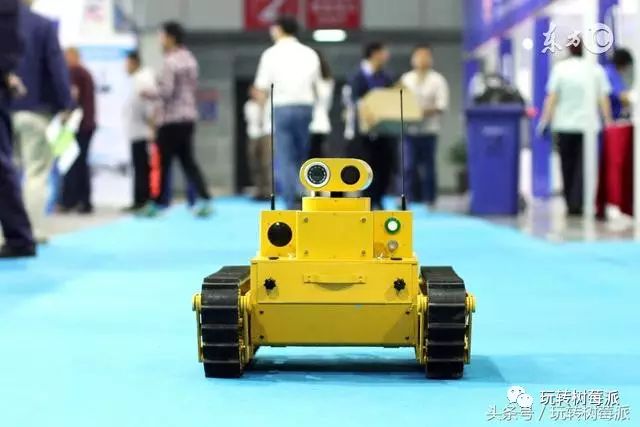您好,登錄后才能下訂單哦!
您好,登錄后才能下訂單哦!
樹莓派智能小車結合攝像頭opencv進行物體追蹤的示例分析,相信很多沒有經驗的人對此束手無策,為此本文總結了問題出現的原因和解決方法,通過這篇文章希望你能解決這個問題。
在幾天的資料整理之后發現是利用opencv和python實現的。那么今天告訴大家如何安裝opencv3.0和如何利用它實現我的小車追蹤。
之前確實安裝過幾次opencv都倒在了cmake編譯的路上,但有問題就得解決。翻了好幾個帖子終于找到了一個靠譜的。用了一個下午的時間終于安裝成功了。安裝的教程篇幅過長且容易被頭條認為成抄襲所以就在發到評論區吧。然后問題來了,opencv安裝好了,怎么實現物體追蹤呢。我開始在github上找案列,找啊找啊找,輸入關鍵字 track car raspberry,找到一個,打開看看是樹莓派加arduino做的。還好arduino只是用來控制步進電機的。我開始把樹莓派gpio控制電機的部分移植到這個項目中。在一天的調試之后,改造版的樹莓派物體追蹤小車出爐了。怎么說呢,這只是個雛形,因為小車轉向不夠靈敏,追蹤的功能需要進一步優化。個人水平有限,希望大家一起來研究。
來說說detect.py 小車物體追蹤的源碼。detect.py中物體追蹤是怎么實現的呢,首先它需要捕捉一個frame邊框并確定一個物體去追蹤。在確定了所要追蹤的物體之后,小車將保持對物體的追蹤。源碼中定義了前后左右和停止的動作。當被鎖定的物體移動時,小車則根據物體的位置作出響應即追蹤物體前進。
#導入一些必須的包
from picamera.array import PiRGBArray
from picamera import PiCamera
import cv2
import serial
import syslog
import time
import numpy as np
import RPi.GPIO as GPIO
# 定義捕捉的畫面尺寸
width = 320
height = 240
tracking_width = 40
tracking_height = 40
auto_mode = 0
#如下定義小車前后左右的功能函數
def t_stop():
GPIO.output(11, False)
GPIO.output(12, False)
GPIO.output(15, False)
GPIO.output(16, False)
def t_up():
GPIO.output(11, True)
GPIO.output(12, False)
GPIO.output(15, True)
GPIO.output(16, False)
time.sleep(0.05)
GPIO.output(11, False)
GPIO.output(12, False)
GPIO.output(15, False)
GPIO.output(16, False)
time.sleep(0.3)
def t_down():
GPIO.output(11, False)
GPIO.output(12, True)
GPIO.output(15, False)
GPIO.output(16, True)
def t_left():
GPIO.output(11, False)
GPIO.output(12, True)
GPIO.output(15, True)
GPIO.output(16, False)
time.sleep(0.05)
GPIO.output(11, False)
GPIO.output(12, False)
GPIO.output(15, False)
GPIO.output(16, False)
time.sleep(0.3)
def t_right():
GPIO.output(11, True)
GPIO.output(12, False)
GPIO.output(15, False)
GPIO.output(16, True)
time.sleep(0.05)
GPIO.output(11, False)
GPIO.output(12, False)
GPIO.output(15, False)
GPIO.output(16, False)
time.sleep(0.3)
def t_open():
GPIO.setup(22,GPIO.OUT)
GPIO.output(22,GPIO.LOW)
def t_close():
GPIO.setup(22,GPIO.IN)
def check_for_direction(position_x):
GPIO.setmode(GPIO.BOARD)
GPIO.setwarnings(False)
GPIO.setup(11,GPIO.OUT)
GPIO.setup(12,GPIO.OUT)
GPIO.setup(15,GPIO.OUT)
GPIO.setup(16,GPIO.OUT)
GPIO.setup(38,GPIO.OUT)
if position_x == 0 or position_x == width:
print 'out of bound'
t_stop()
if position_x <= ((width-tracking_width)/2 - tracking_width):
print 'move right!'
t_right()
elif position_x >= ((width-tracking_width)/2 + tracking_width):
print 'move left!'
t_left()
else:
# print 'move front'
t_up()
# initialize the camera and grab a reference to the raw camera capture
camera = PiCamera()

圖文無關
camera.resolution = (width, height)
camera.framerate = 32
rawCapture = PiRGBArray(camera, size=(width, height))
rawCapture2 = PiRGBArray(camera, size=(width, height))
# allow the camera to warmup
time.sleep(0.1)
# set the ROI (Region of Interest)
c,r,w,h = (width/2 - tracking_width/2), (height/2 - tracking_height/2), tracking_width, tracking_height
track_window = (c,r,w,h)
# capture single frame of tracking image
camera.capture(rawCapture2, format='bgr')
# create mask and normalized histogram
roi = rawCapture2.array[r:r+h, c:c+w]
hsv_roi = cv2.cvtColor(roi, cv2.COLOR_BGR2HSV)
mask = cv2.inRange(hsv_roi, np.array([0,30,32]), np.array([180,255,255]))
roi_hist = cv2.calcHist([hsv_roi], [0], mask, [180], [0,180])
cv2.normalize(roi_hist, roi_hist, 0, 255, cv2.NORM_MINMAX)
term_crit = (cv2.TERM_CRITERIA_EPS | cv2.TERM_CRITERIA_COUNT, 80, 1)
# capture frames from the camera
for frame in camera.capture_continuous(rawCapture, format='bgr', use_video_port=True):
# grab the raw NumPy array representing the image, then initialize the timestamp
# and occupied/unoccupied text
image = frame.array
# filtering for tracking algorithm
hsv = cv2.cvtColor(image, cv2.COLOR_BGR2HSV)
dst = cv2.calcBackProject([hsv], [0], roi_hist, [0,180], 1)
ret, track_window = cv2.meanShift(dst, track_window, term_crit)
x,y,w,h = track_window
cv2.rectangle(image, (x,y), (x+w,y+h), 255, 2)
cv2.putText(image, 'Tracked', (x-25, y-10), cv2.FONT_HERSHEY_SIMPLEX, 1, (255, 255, 255), 2)
# show the frame
cv2.imshow("Raspberry Pi RC Car", image)
key = cv2.waitKey(1) & 0xFF
check_for_direction(x)
time.sleep(0.01)
# clear the stream in preparation for the next frame
rawCapture.truncate(0)
看完上述內容,你們掌握樹莓派智能小車結合攝像頭opencv進行物體追蹤的示例分析的方法了嗎?如果還想學到更多技能或想了解更多相關內容,歡迎關注億速云行業資訊頻道,感謝各位的閱讀!
免責聲明:本站發布的內容(圖片、視頻和文字)以原創、轉載和分享為主,文章觀點不代表本網站立場,如果涉及侵權請聯系站長郵箱:is@yisu.com進行舉報,并提供相關證據,一經查實,將立刻刪除涉嫌侵權內容。